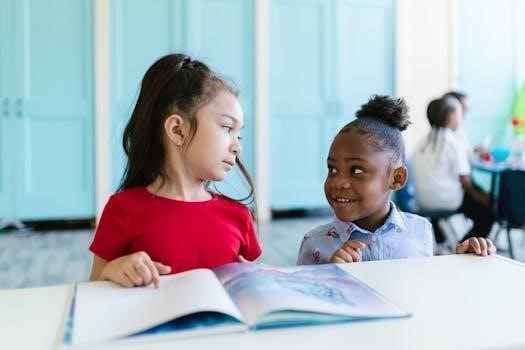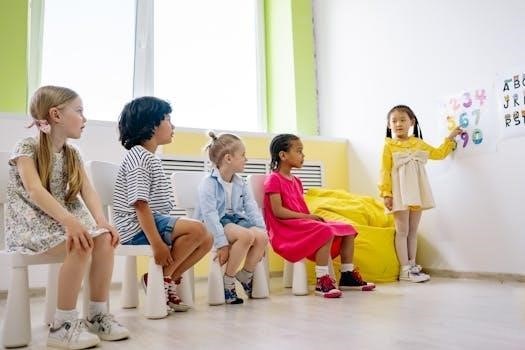Inclusive classrooms embrace diversity, offering a supportive space where all students, regardless of their challenges, can thrive․ It’s about creating equity and fostering a sense of belonging․ This approach ensures every learner feels valued and receives tailored support to succeed academically and socially․
Defining Struggling Learners in Inclusive Settings
Within inclusive classrooms, “struggling learners” encompass a diverse group of students facing various academic, social, emotional, or behavioral challenges that hinder their progress․ These challenges can stem from learning disabilities like dyslexia or dysgraphia, attention-deficit/hyperactivity disorder (ADHD), emotional or behavioral disorders, or a lack of prior knowledge or adequate support․ Identifying these learners requires careful observation, assessment, and data collection, going beyond standardized tests to encompass classroom performance, engagement levels, and social interactions․ It’s crucial to recognize that struggling learners are not defined by a single deficit but by a combination of factors that impact their ability to access and engage with the curriculum․ Effective identification involves collaboration between teachers, special education staff, parents, and the students themselves to gain a holistic understanding of their strengths and needs․ Moreover, it’s essential to avoid labeling students based solely on their struggles, as this can lead to lowered expectations and self-fulfilling prophecies․ Instead, focus on providing targeted interventions and support that address their specific needs while fostering a growth mindset and belief in their potential․ This definition emphasizes the importance of understanding the individual context of each learner within the inclusive setting, recognizing that their struggles are often multifaceted and require a personalized approach to support their success․ By moving away from deficit-based thinking and embracing a strengths-based perspective, educators can create a truly inclusive environment where all students have the opportunity to reach their full potential․

Research-Backed Strategies and Intervention Models
Numerous research-backed strategies and intervention models can effectively support struggling learners in inclusive classrooms․ Multi-Tiered Systems of Support (MTSS) provide a framework for differentiated instruction and intervention, with increasing levels of support based on student needs․ Response to Intervention (RTI), a key component of MTSS, focuses on early identification and intervention for students at risk of academic failure, utilizing data-driven decision-making to adjust instruction and monitor progress․ Explicit instruction, characterized by clear explanations, modeling, guided practice, and independent practice, has proven highly effective for students with learning disabilities․ Cognitive strategies, such as self-monitoring, self-regulation, and metacognitive training, empower students to take ownership of their learning and develop effective study skills․ Peer-assisted learning strategies (PALS) involve students working together in pairs or small groups to support each other’s learning, fostering collaboration and social skills․ Universal Design for Learning (UDL) principles guide the creation of flexible and accessible learning environments that cater to diverse learner needs, reducing barriers to learning and promoting engagement․ Assistive technology, including software, hardware, and apps, can provide students with disabilities access to the curriculum and tools to enhance their learning․ Effective intervention models often incorporate a combination of these strategies, tailored to the specific needs of the individual student․ Research consistently demonstrates that early intervention is crucial for preventing academic difficulties from escalating, highlighting the importance of proactive identification and support․ Furthermore, ongoing progress monitoring and data analysis are essential for evaluating the effectiveness of interventions and making necessary adjustments․ By implementing research-backed strategies and intervention models, educators can create inclusive classrooms where all students have the opportunity to succeed․

Actionable Techniques to Support Diverse Learners
To effectively support diverse learners in an inclusive classroom, educators can implement a range of actionable techniques․ First and foremost, differentiate instruction by tailoring content, process, product, and environment to meet individual student needs․ This may involve providing varied reading materials, offering choices in how students demonstrate their understanding, or adjusting the pace of instruction․ Scaffold learning by breaking down complex tasks into smaller, manageable steps, providing support and guidance along the way․ Use graphic organizers to help students visualize information, organize their thoughts, and make connections between concepts․ Implement flexible grouping strategies, allowing students to work in small groups, pairs, or individually based on their learning needs and preferences․ Provide assistive technology tools, such as text-to-speech software or speech-to-text software, to support students with reading, writing, or communication challenges․ Incorporate visual aids, such as pictures, diagrams, and videos, to enhance understanding and engagement․ Offer frequent opportunities for practice and feedback, providing students with specific and constructive guidance to improve their skills․ Create a multi-sensory learning environment by incorporating activities that appeal to different senses, such as touch, sight, sound, and movement․ Foster a growth mindset by encouraging students to embrace challenges, persist through difficulties, and view mistakes as opportunities for learning․ Collaborate with specialists, such as special education teachers, reading specialists, and counselors, to develop individualized support plans for students with specific needs․ Establish clear expectations and routines to provide structure and predictability, reducing anxiety and promoting positive behavior․ Utilize peer tutoring or mentoring programs, pairing students who need support with those who can provide assistance․ Regularly assess student progress and adjust instruction accordingly, using data to inform decision-making and ensure that students are making adequate gains․ By implementing these actionable techniques, educators can create a supportive and engaging learning environment where all diverse learners can thrive․

Creating a Positive and Supportive Classroom Climate
Establishing a positive and supportive classroom climate is paramount for the success of all learners, especially those who struggle․ This involves fostering a sense of belonging, respect, and safety where students feel valued, understood, and empowered to take risks․ Begin by building strong relationships with each student, taking the time to learn about their individual strengths, interests, and challenges․ Show genuine care and empathy, creating a safe space for students to share their thoughts and feelings without fear of judgment․ Implement strategies to promote positive social interactions, such as cooperative learning activities, group projects, and class discussions that encourage collaboration and teamwork․ Establish clear expectations for behavior and consistently reinforce positive behaviors, focusing on praise and encouragement rather than punishment․ Create a visually appealing and organized classroom environment that is conducive to learning, with comfortable seating, accessible materials, and stimulating displays․ Incorporate mindfulness practices, such as deep breathing exercises or guided meditation, to help students manage stress and anxiety․ Promote a growth mindset by encouraging students to embrace challenges, persist through difficulties, and view mistakes as opportunities for learning․ Celebrate diversity by incorporating multicultural perspectives and experiences into the curriculum, fostering an appreciation for different cultures, backgrounds, and abilities․ Encourage student voice and choice by providing opportunities for students to make decisions about their learning, such as selecting topics for research projects or choosing how to demonstrate their understanding․ Foster a sense of community by organizing class-building activities, such as games, icebreakers, and social events, that promote connection and camaraderie․ Implement restorative justice practices to address conflict and resolve disputes in a fair and equitable manner, focusing on repairing harm and restoring relationships․ Provide opportunities for students to develop self-advocacy skills, empowering them to communicate their needs and seek support when necessary․ By creating a positive and supportive classroom climate, educators can foster a sense of belonging, promote student well-being, and enhance academic achievement for all learners․

Differentiated Instruction and UDL Principles
Differentiated instruction and Universal Design for Learning (UDL) principles are critical components of creating inclusive classrooms that effectively support struggling learners․ Differentiated instruction involves tailoring instruction to meet the diverse needs of students by modifying content, process, product, or learning environment․ UDL, on the other hand, is a framework that guides the design of instructional goals, methods, materials, and assessments that are flexible and adaptable to accommodate the widest range of learner differences․ Together, these approaches create a learning environment where all students can access, engage with, and succeed in the curriculum․ To implement differentiated instruction, educators can use various strategies, such as providing tiered assignments that offer different levels of challenge, offering choice boards that allow students to select activities based on their interests and learning styles, and using flexible grouping to pair students with similar or different skill levels for collaborative work․ Content can be differentiated by adjusting the complexity of the material, providing scaffolding for struggling learners, and offering enrichment activities for advanced learners․ Process can be differentiated by providing different learning activities, such as hands-on experiments, visual aids, or auditory presentations․ Product can be differentiated by allowing students to demonstrate their understanding through various formats, such as written reports, oral presentations, or multimedia projects․ The learning environment can be differentiated by creating flexible seating arrangements, providing quiet areas for focused work, and using technology to enhance learning․ UDL principles provide a framework for designing instruction that is accessible to all students․ These principles include providing multiple means of representation (e․g․, using visual, auditory, and tactile methods to present information), multiple means of action and expression (e․g․, allowing students to demonstrate their understanding through various formats), and multiple means of engagement (e․g․, providing choices, relevance, and opportunities for collaboration)․ By incorporating differentiated instruction and UDL principles into their teaching practices, educators can create inclusive classrooms where all students can thrive, regardless of their learning challenges․
